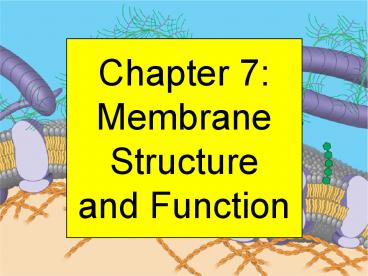Chapter 7: Membrane Structure and Function - PowerPoint PPT Presentation
1 / 44
Title:
Chapter 7: Membrane Structure and Function
Description:
Chapter 7: Membrane Structure and Function Important Point: Lipid Bilayer Fluid Mosaic Model History of Fluid Mosaic Model Movement of Phospholipids Membrane Fluidity ... – PowerPoint PPT presentation
Number of Views:95
Avg rating:3.0/5.0
Title: Chapter 7: Membrane Structure and Function
1
Chapter 7MembraneStructureand Function
2
Important Point
If you are having trouble understanding lecture
material Try reading your text before
attending lectures. And take the time to read it
well!
3
Lipid Bilayer
The ability of the cell to discriminate in its
chemical exchanges with the environment is
fundamental to life, and it is the plasma
membrane that makes this selectivity possible.
4
Fluid Mosaic Model
5
History of Fluid Mosaic Model
For more on this history, see http//www1.umn.edu
/ships/9-2/membrane.htm
6
Movement of Phospholipids
7
Membrane Fluidity
8
Cholesterol Temp. Buffer
Cholesterol reduces membrane fluidity at
moderate temperatures by reducing phospholipid
movement, but at low temperatures it hinders
solidification by disrupting regular packing of
phospholipids. Campbell Reece (2005) p. 126
9
Lateral Movement of Proteins
Protein diffusion is not as fast as phospholipid
diffusion
10
Not all Proteins Move
Proteins attached to cytoskeleton or ECM dont
move
11
Transmembrane Protein
Know definition of transmembrane protein
Note distinct orientation
12
Membrane Proteins
13
Membrane Protein Functions
Membrane asymmetry allows cells to automatically
differ their intracellular environment from that
existing extracellularly
14
Membrane Protein Functions
15
Membrane Protein Trafficking
Note the equivalent orientation of endomembrane
lumen and extracelullar environment
Note the orientation of carbohydrate (always
lumen or outside of cell)
16
Transport Across Membranes
Active transport is pumping against concentration
gradients
17
Primer on Diffusion
- Diffusion is movement from area of high
concentration to low - Diffusion is Passive Transport no energy is
required
18
Passive Transport
19
Passive Transport
20
Simple Diffusion Across Bilayers
- Unaided by transport proteins
- No metabolic energy expended
- Movement is down chemical concentration gradient
- Diffusion rate is proportional to concentration
gradient and hydrophobicity - Rate limiting step is movement across hydrophobic
portion of membrane - The greater the hydrophobicity of a water-soluble
molecule, the faster it diffuses across
phospholipid bilayer
Selective permeability
21
Simple Diffusion Across Bilayers
22
Osmosis
More water
Less water
Down waters concentration gradient
23
Osmosis H20 Down Conc. Gradient
Equilibrium
24
Tonicity
More solute in than out
25
Facilitated Diffusion
26
Facilitated Diffusion
The parallels between the properties of transport
proteins and enzymes are fairly extensive, to the
point where one may consider a transport protein
simply as an enzyme-like protein that catalyzes
the physical process of movement from one side of
a membrane to another
27
Group Translocation
Note that ATP-mediated phosphorylation of glucose
inside of cell drives this transport, making it
an example Group Translocation
28
Sodium-Potassium Pump
29
Sodium-Potassium Pump
- The sodium-potassium pump is a specific (and
important) example ATP-powered active transport - In addition to their intrinsic relevance,
studying membrane-transport proteins allows us to
appreciate mechanisms of protein-mediated
catalysis without getting bogged down in the
details of chemical reactions! - As we shall see, there are other means of
powering active transport that dont involve a
direct hydrolysis of ATP - First, though, we will take another look at the
sodium-potassium pump
30
Sodium-Potassium Pump
Why is the sodium-potassium pump considered to be
an eletrongenic pump?
31
Electrochemical Gradient
- An Electrochemical Gradient is a Concentration
Gradient with Ions - These ions want to move down their concentration
gradient - These ions (particularly) also want to move
towards the opposite charge found on the other
side of the membrane - This attraction for the other side of membranes
(membrane potential) can be harnessed to do work - Electrochemical gradients essentially are
batteries, i.e., means of physically storing
electrical energy - Proton pumps are used by plants, bacteria, and
fungi to create electrochemical gradients - Sodium-potassium pumps are employed by animals
for the same purpose
32
Movement Across Membranes
33
Movement Down Conc. Gradient
34
Electrogenic Pump
35
Electron Transport Proton Pumping
36
Cotranport as Active Transport
37
Movement Across Membranes
- Endocytosis
- Phagocytosis
- Pinocytosis
- Receptor mediated endocytosis
- Exocytosis
- These are mechanisms that involve movement into
and out of the lumen of the endomembrane system - Not movement directly across membrane
- That is, substances enter the Endomembrane System
but not the Cytoplasm
38
Phagocytosis
Allows digestion in confined space
Taking up solids
39
Phagocytosis Examples
40
Pinocytosis
Taking up fluids
Increases absorptive membrane area
41
Receptor-Mediated Endocytosis
A way of taking up specific substances
42
Exocytosis
Exocytosis
43
Endocytosis Membrane Orientation
44
The End































